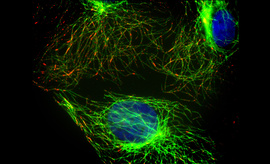The cytosolic chaperone α-Crystallin B rescues appropriate folding and compartmentalization of misfolded multispan transmembrane proteins
α–Crystallin B chain (CRYAB or also HspB5) is a cytosolic chaperone belonging to the small heat shock protein family and is known to help the folding of different cytosolic proteins. Here we show that CRYAB binds the mutant form of at least two multispan transmembrane proteins (TMPs), exerting on them an anti-aggregation activity. It rescues the folding of the mutant Frizzled4 that is responsible for a rare autosomal dominant form of Familial exudative vitreoretinopathy (Fz4-FEVR); and of the mutant ATP7B Cu transporter (ATP7B-H1069Q) associated with a common form of Wilson's Disease. In the case of Fz4-FEVR, CRYAB prevents the formation of inter-chain disulfide bridges between the lumenal ectodomains of the aggregated mutant chains, which enables correct folding and promotes appropriate compartmentalization on the plasma membrane. ATP7B-H1069Q, with help from CRYAB, reaches a proper conformation, moves to the Golgi complex, and responds to Cu overload as wt ATP7B. These findings strongly suggest that CRYAB plays a pivotal role, previously undetected, in the folding of multispan TMPs and is able to orchestrate from the cytosol folding events that take place in the lumen of the ER. Our results contribute to the explanation of the complex scenario behind multispan TMPs folding; additionally, they serve to expose interesting avenues for novel therapeutic approaches.

